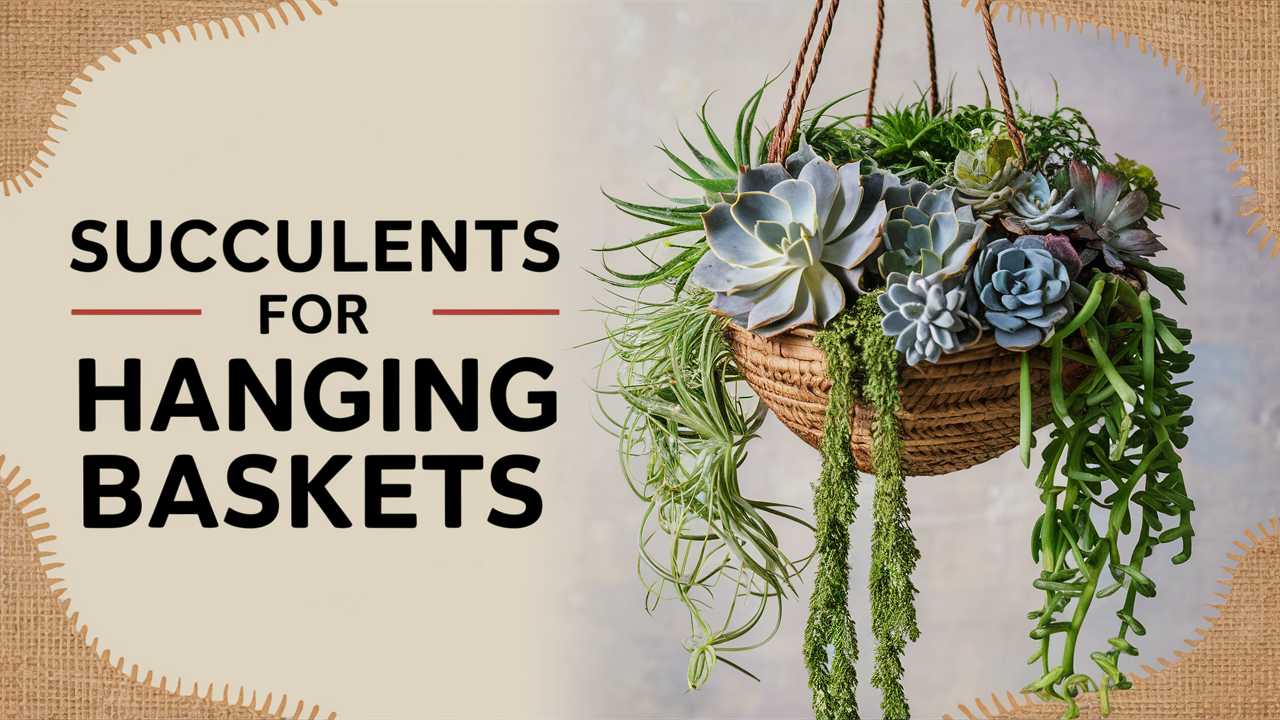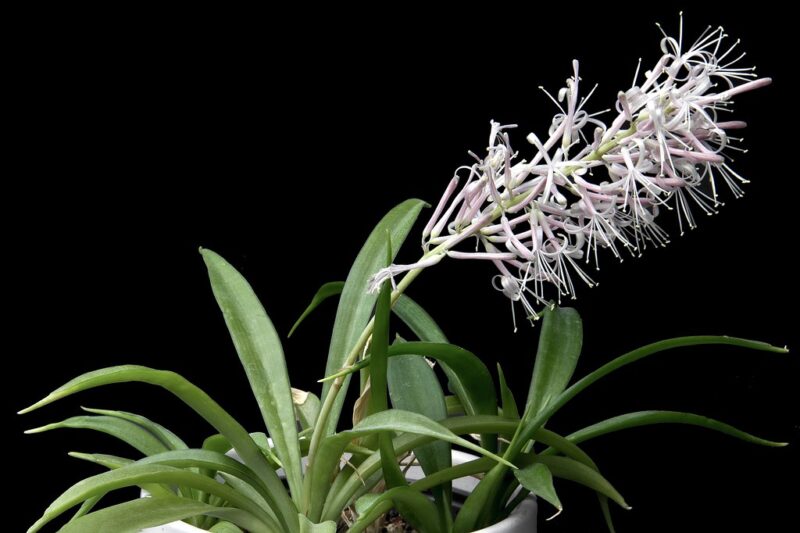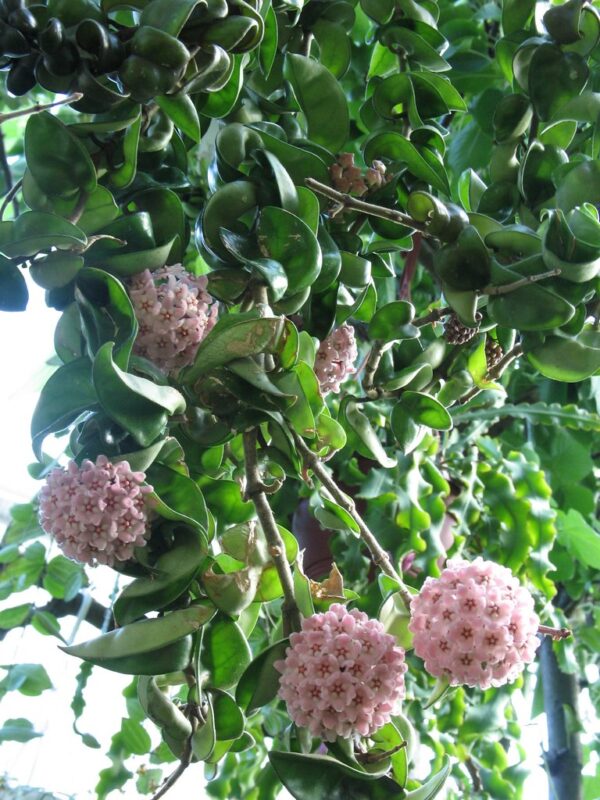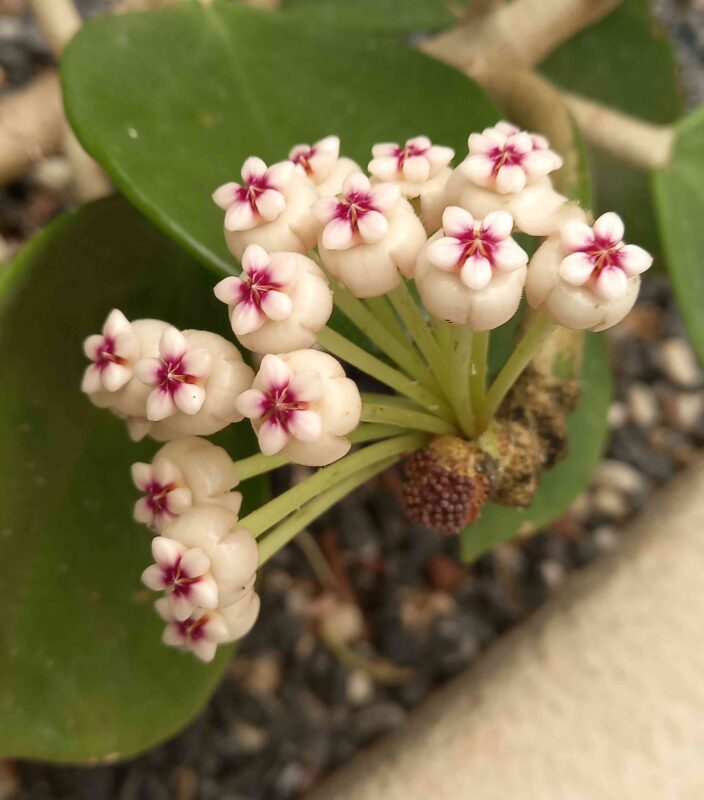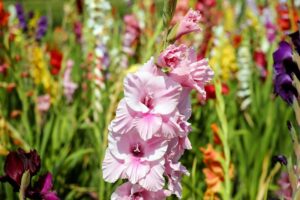This post will explore various succulent species that thrive in hanging baskets, each bringing its charm to your vertical garden.
Burro’s Tail – Sedum Morganianum

Burro’s Tail, also known as Sedum Morganianum, is a charming succulent that features long, trailing stems adorned with plump, blue-green leaves. This succulent can produce cascading tendrils that may reach lengths of up to 3 feet, making it an impressive addition to hanging containers. It’s essential to remember that Burro’s Tail prefers bright, indirect sunlight but should be protected from harsh afternoon rays, which can scorch its leaves.
This species is quite forgiving, thriving in various soil types, provided they have excellent drainage. Watering should be done sparingly, allowing the soil to dry out fully between waterings to prevent root rot. Burro’s Tail is also an excellent plant for beginners; it can tolerate neglect, found in homes with varying humidity levels.
String Of Pearls – Senecio Rowleyanus
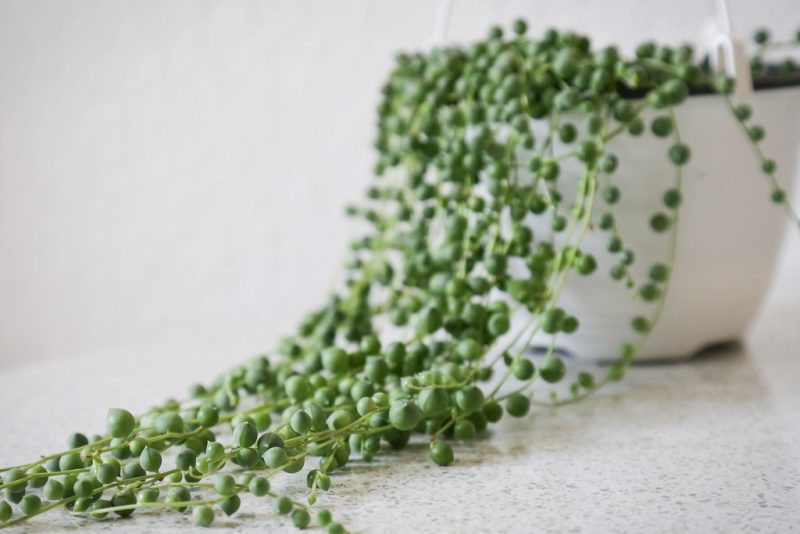
Renowned for its unique appearance, the String of Pearls (Senecio Rowleyanus) features a stunning cascade of spherical leaves that resemble small beads along a string. This succulent is ideal for hanging baskets, as it gracefully spills over the sides, creating a striking visual effect that catches the eye.
String of Pearls thrives in bright, indirect sunlight and is drought-tolerant, making it an excellent choice for those who may forget to water occasionally. However, it’s crucial to avoid overwatering, as the beads can start to rot if kept in soggy conditions. Fertilization is generally not necessary, but a diluted liquid fertilizer can be applied during the growing season to promote healthy growth.
This charming plant also resonates with those who appreciate a touch of whimsy in their garden decor, making it a favorite among succulent enthusiasts.
Kenya Hyacinth – Sansevieria Parva
The Kenya Hyacinth, or Sansevieria Parva, is another beautiful succulent worthy of hanging basket consideration. Its rosettes of dark green leaves are accented with light green horizontal stripes, creating an elegant appearance. While often grown as a tabletop plant, its compact stature makes it adaptable for hanging arrangements.
Much like its relatives in the Sansevieria family, the Kenya Hyacinth is renowned for its durability and resilience. It requires minimal maintenance and can thrive in low-light conditions, making it a perfect option for indoor hanging baskets. The plant can tolerate infrequent watering, with a good rule of thumb being to allow the soil to dry entirely before the next watering session.
Ruby Necklace – Othonna Capensis

Othonna Capensis, commonly referred to as the Ruby Necklace, is a succulent that makes a stunning statement in hanging baskets. This plant features elongated, purple-hued leaves that trail beautifully from the container, reminiscent of a delicate necklace. The vivid coloration can brighten up any space, providing a pop of rich, jewel-like tones.
Ruby Necklace enjoys bright, indirect sunlight, promoting vibrant foliage. It prefers moderately well-draining soil and must be watered once the top couple of inches are dry. When providing care, ensure to avoid excess moisture, as it can lead to root rot, a common concern with more sensitive succulents. The Ruby Necklace is an outstanding choice for adding elegance and flair to indoor gardens or patios.
String Of Hearts – Ceropegia Woodii
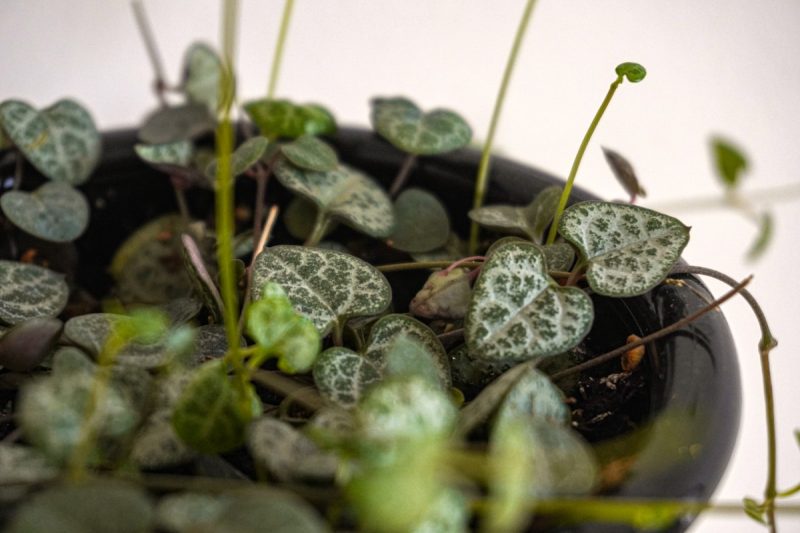
The String of Hearts (Ceropegia Woodii) is a beloved succulent known for its heart-shaped leaves, which grow on slender, delicate stems. This cascading plant creates a romantic and charming appearance, making it a favored option for those aiming to add a touch of warmth and love to their space.
This succulent thrives best in bright, indirect light, welcoming some direct sun as well. It prefers a well-draining potting mix, allowing for excellent airflow around the roots. Watering should be approached conservatively, letting the soil dry out between waterings. Inappropriate moisture levels can lead to leaf drop or root rot, so vigilance is essential.
The lightweight nature and trailing characteristics of the String of Hearts enable it to be an ideal choice for hanging baskets, where its graceful vines can flow elegantly over the edges.
String Of Nickels – Dischidia Nummularia
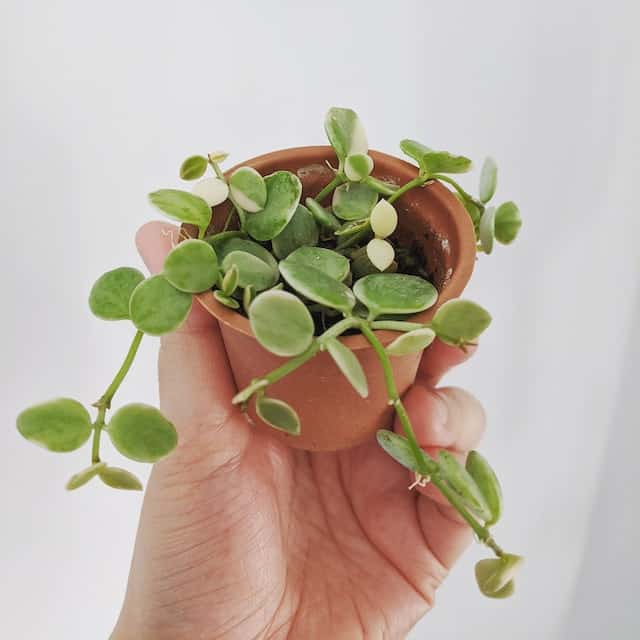
Dischidia Nummularia, commonly called the String of Nickels, showcases round, coin-shaped leaves that grow densely on long vines. This succulent is not only unique in appearance but is also known for being a robust and adaptable plant. Its lush green foliage adds a refreshing touch to any hanging arrangement.
The String of Nickels flourishes best in bright, indirect sunlight, although it can tolerate some shade. When it comes to watering, allow the top layer of soil to dry out before giving it another drink. Overwatering can lead to root rot, so maintaining a careful balance is crucial.
This succulent can also produce lovely clusters of flowers under the right conditions, showcasing its versatility as both a decorative and flowering plant.
String Of Tears – Senecio Herreianus

Senecio Herreianus, or String of Tears, gets its name from its trailing tendrils that resemble teardrops. This succulent adds a playful and whimsical element to hanging baskets, with its long vines cascading beautifully from the container. The unique shape of its leaves makes it visually intriguing and a conversation starter in any home.
String of Tears thrives in well-draining soil and prefers bright, indirect sunlight. However, it is also capable of adapting to lower light environments, making it an excellent choice for those with less-than-ideal lighting conditions. Watering should be done moderately; allowing the soil to dry fully between waterings will help maintain its health and vibrance.
Its cascading growth habit makes String of Tears a wonderful candidate for hanging and encourages growth that adds depth to your green arrangement, impacting any space it occupies.
String Of Bananas – Senecio Radicans
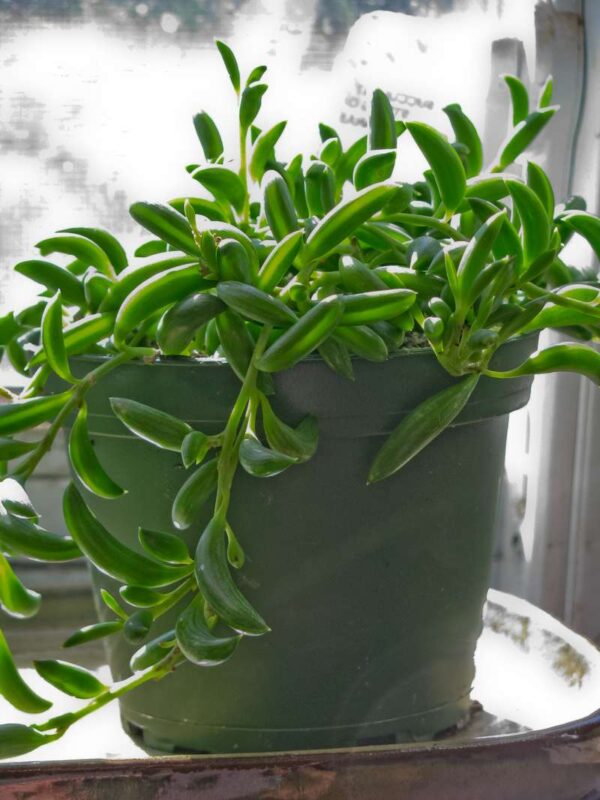
If you’re looking for a playful touch, the String of Bananas (Senecio Radicans) is the succulent for you. Resembling small bananas on a vine, this unique plant not only adds visual interest but also captures the imagination with its delightful appearance.
String of Bananas prefers a bright, indirect light environment combined with well-draining soil. Like most succulents, it is essential to allow the soil to dry out between waterings to avoid over-saturation. This plant can tolerate some drought, but you should keep an eye on its leaves; they will shrivel slightly when it requires water.
As this succulent trails down from a hanging basket, its charming banana-shaped leaves create a playful effect, making it a fun addition to any indoor or outdoor hanging arrangement.
Crassula Pellucida Variegata
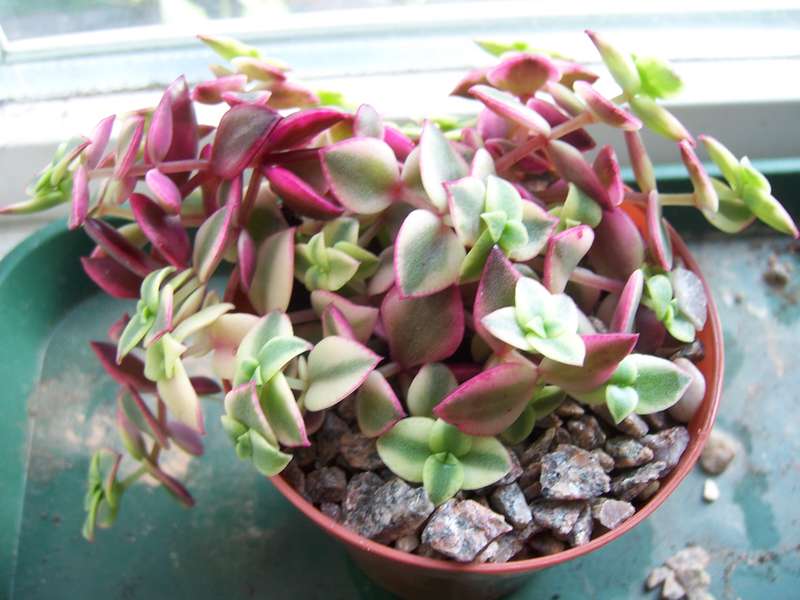
Crassula Pellucida Variegata, often referred to as the Variegated Crassula, is a delightful succulent known for its stunning, translucent leaves that can range from green to creamy-white. Its unique foliage provides a soft and delicate look, making it a captivating choice for hanging baskets.
This Variegated Crassula thrives in bright light conditions but can adapt to indirect sunlight if necessary. It prefers a well-draining soil mix and should be watered when the top inch of soil has dried out. Fertilizing this succulent during the growing season can enhance its colors and promote further growth.
With its eye-catching variegation and trailing nature, the Variegated Crassula adds an elegant touch while flourishing effortlessly in hanging arrangements.
Hindu Rope – Hoya Carnosa Compacta
Often referred to as the Hindu Rope Hoya, the Hoya Carnosa Compacta is known for its unique, thick, twisted leaves that grow in a spiral. This succulent is an excellent option for hanging baskets, as its robust leaves will trail elegantly, creating a lush canopy of green.
This plant thrives in bright, indirect sunlight. It prefers soil that is not too rich but retains some moisture to keep the root system happy. While Hoyas appreciate watering, be careful not to overwet the roots; instead, let the potting mix dry somewhat in between watering sessions.
The Hindu Rope’s striking appearance pairs well with its compact growth habit, making it an excellent succulent for anyone looking to add a touch of the exotic to their home.
Rattail Cactus – Aporocactus Flagelliformis
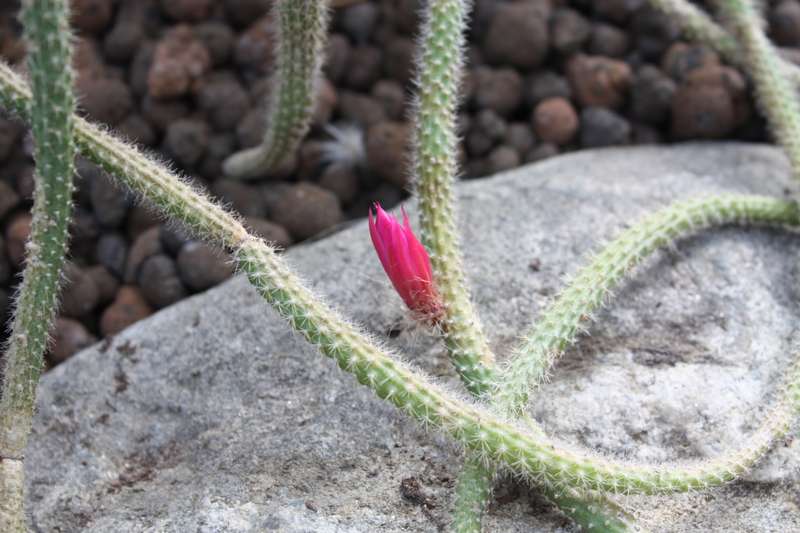
The Rattail Cactus (Aporocactus Flagelliformis) is a fast-growing succulent known for its long, trailing stems adorned with spines. This unique growth habit makes it a fascinating addition to our list of hanging basket plants. Often producing vibrant pink or red blooms, the Rattail Cactus offers both lush green growth and a delightful splash of color.
This cactus prefers bright, direct sunlight and requires well-draining soil to maintain optimal health. Watering should be approached with caution, offering water only when the soil has dried thoroughly. As a cactus, it is crucial to avoid soggy conditions to prevent root rot.
With its distinctive cascading form and beautiful flowering potential, the Rattail Cactus adds an element of unique beauty and charm to your hanging baskets.
Peanut Cactus – Echinopsis Chamaecereus
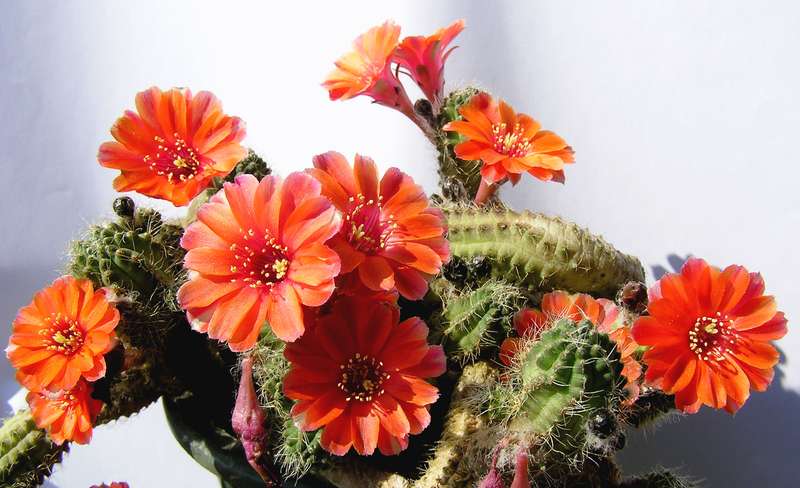
The Peanut Cactus (Echinopsis Chamaecereus) is a quirky succulent that grows in a cylindrical shape, resembling tiny peanuts clustered together. This cactus can produce stunning vibrant flowers that bloom in spring and summer, making it a sought-after choice for hanging arrangements.
This delightful cactus thrives in bright, indirect sunlight and requires well-draining soil. Watering should be performed sparingly; allow the soil to dry completely between watering sessions to avoid root rot. Additionally, a balanced cactus fertilizer can be used sparingly to promote healthy growth and flowering.
As the Peanut Cactus grows, it will develop a cascade of its unique cylindrical shape, creating an enticing and conversation-worthy hanging display.
Monkey’s Tail – Hildewintera Colademononis
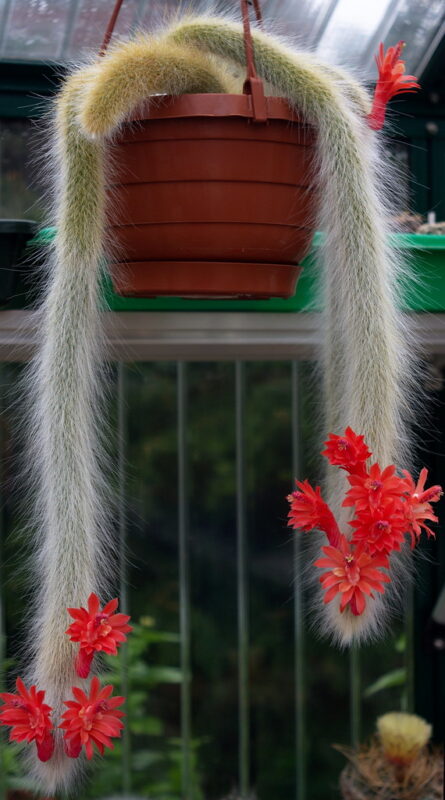
The Monkey’s Tail cactus (Hildewintera Colademononis) features long, fuzzy, trailing stems, giving it a unique and tropical appearance. This eye-catching succulent can be an entertaining addition to your hanging baskets, as its thick, hairy tails can cascade beautifully over the sides.
This cactus prefers bright, indirect sunlight and will thrive in a well-draining potting mix. When it comes to watering, it’s best to let the soil dry out completely before giving it another drink. This practice helps to prevent root rot and ensures that your Monkey’s Tail remains healthy and vibrant.
The Monkey’s Tail not only captivates with its appearance but also produces fragrant flowers during the right season. This makes it an exceptional, multi-faceted choice for any hanging arrangement.
Trailing Jade – Senecio Jacobsenii
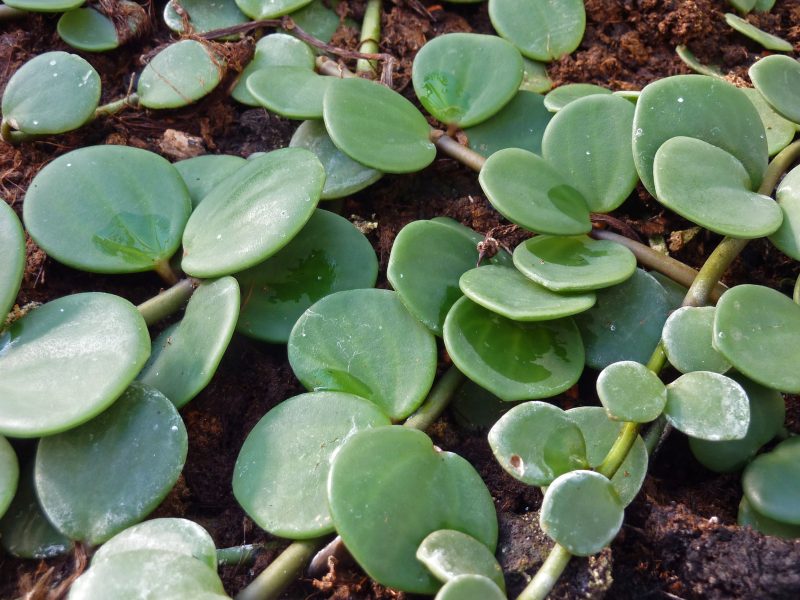
Trailing Jade (Senecio Jacobsenii) is a beautiful succulent known for its plump, streamlined leaves that grow on trailing, thick stems. Often praised for its lovely cascading growth, it provides a touch of beauty without the necessity of constant pampering.
This succulent flourishes in bright, indirect light and thrives in well-draining soil. It’s essential to allow the soil to dry before the next watering, preventing the risk of root rot—common in many varieties of succulent plants.
Trailing Jade can also be trimmed and propagated, making it an excellent option for creating new plants and allowing its lovely foliage to add to other arrangements. With its ease of care and stunning presentation, it’s a delightful addition to any home.
Christmas Cactus – Schlumbergera Bridgesii
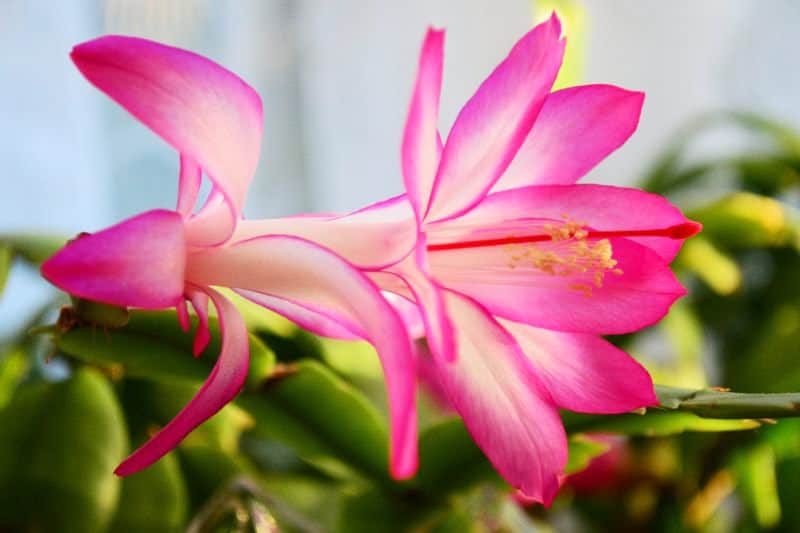
The Christmas Cactus (Schlumbergera Bridgesii) is known for its stunning flowers that bloom in vibrant colors during the holiday season. Unlike traditional cacti, which thrive in arid conditions, the Christmas Cactus prefers a more humid environment, making it an excellent choice for hanging arrangements both indoors and outdoors.
This unique succulent enjoys indirect sunlight and well-draining soil, watered just enough to keep the potting mix lightly moist. Overwatering can lead to root rot, so it’s crucial to strike a balance. When cared for adequately, you’ll be rewarded with its beautiful blooms during the holiday season.
Embedding a Christmas Cactus into your hanging arrangements will provide an eye-catching festive touch and creates a perfect cozy atmosphere for the season.
Dancing Bones – Hatiora Salicornioides
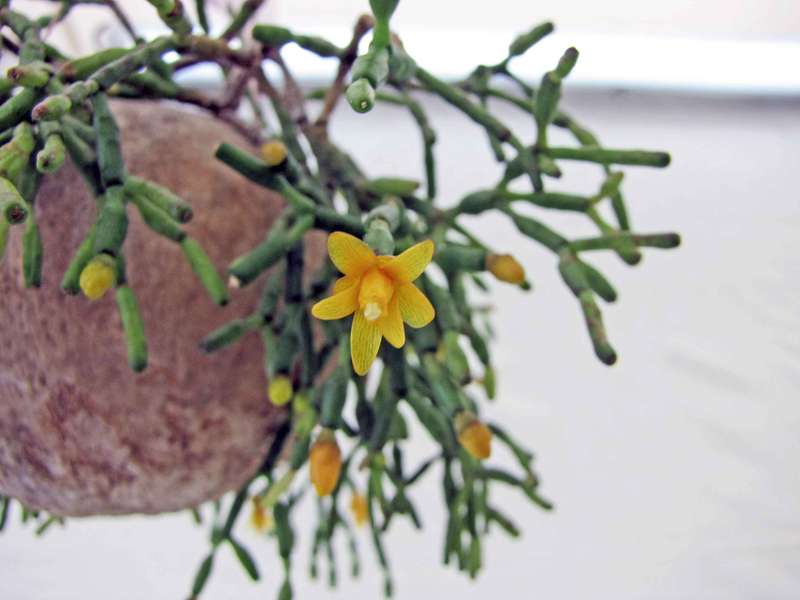
Dancing Bones, or Hatiora Salicornioides, showcases segments of long, slender, jointed stems, resembling a skeleton’s bones or playful limbs. This unique succulent provides a fun and lively element to any hanging arrangement, especially when paired with bright lighting.
It thrives in well-draining soil, preferring bright, indirect sunlight. This plant requires regular watering, allowing the soil to dry out slightly between sessions. Creeping under the right conditions, the Dancing Bones will drape gracefully over the sides of a basket, offering an unusual yet captivating appeal to your indoor decor.
This succulent’s lively identity makes it a whimsical option for hanging baskets, drawing attention and sparking curiosity in any observer.
October Daphne – Sedum Sieboldii
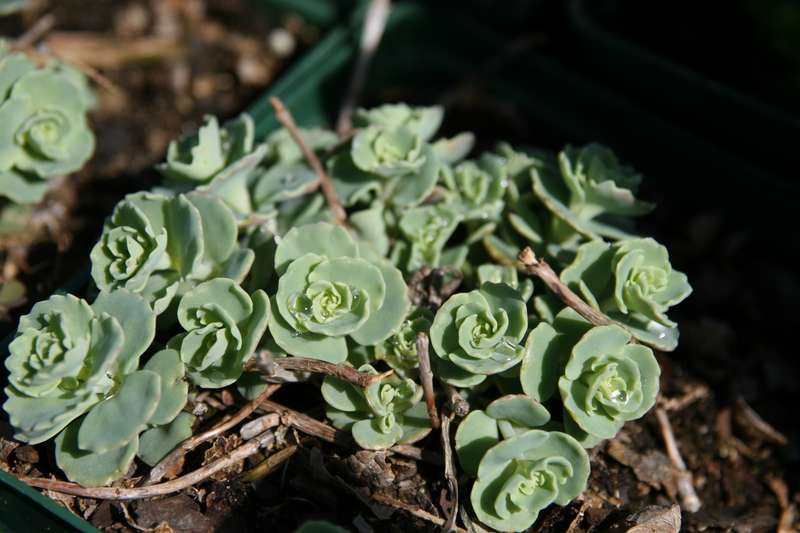
Sedum Sieboldii, commonly referred to as October Daphne, is a beautiful succulent that creates a cascading effect when planted in hanging baskets. This plant features plump, jade-like leaves that can change color to shades of red or purple when exposed to bright sunlight.
October Daphne thrives in well-draining soil and prefers bright, indirect sunlight. As with most succulents, water only when the top few inches of soil are dry. Avoid waterlogging, which can cause root health issues. This plant can produce star-shaped flowers in the cooler months, making it a delightful addition to any hanging display.
With its lovely trailing form, vibrant colors, and seasonal blooms, October Daphne remains a fantastic choice for creating eye-catching arrangements.
Variegated Trailing Jade – Crassula Sarmentosa
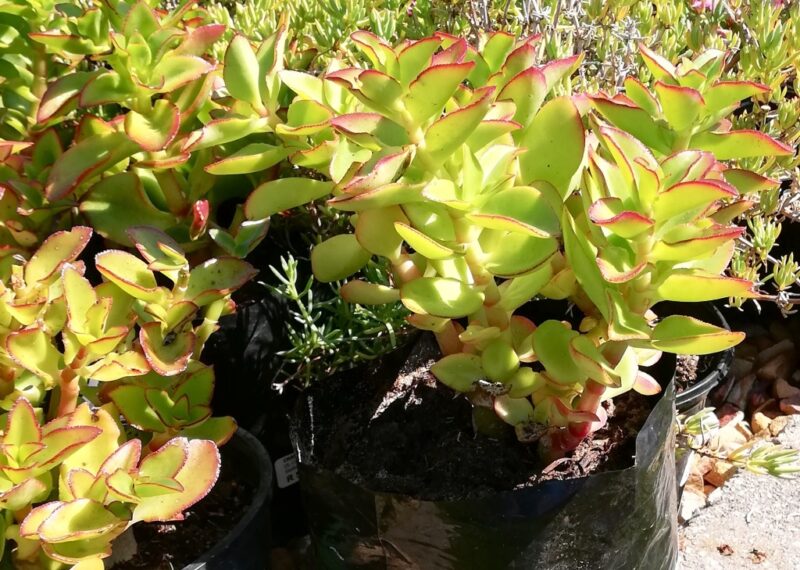
The Variegated Trailing Jade (Crassula Sarmentosa) features a unique color combination of bright greens and creamy whites along its succulent leaves. This captivating plant offers an exotic twist to those looking for an attractive option for their hanging baskets.
This variety thrives best in bright, indirect sunlight, although some exposure to direct light is welcomed. Similar to its relatives, the watering regime should emphasize allowing the soil to dry out between sessions to avoid water accumulation and root issues.
The Variegated Trailing Jade adds a delightful flair to hanging arrangements while being low-maintenance, making it an excellent choice for any plant enthusiast looking to diversify their collection.
String Of Buttons – Crassula Perforata
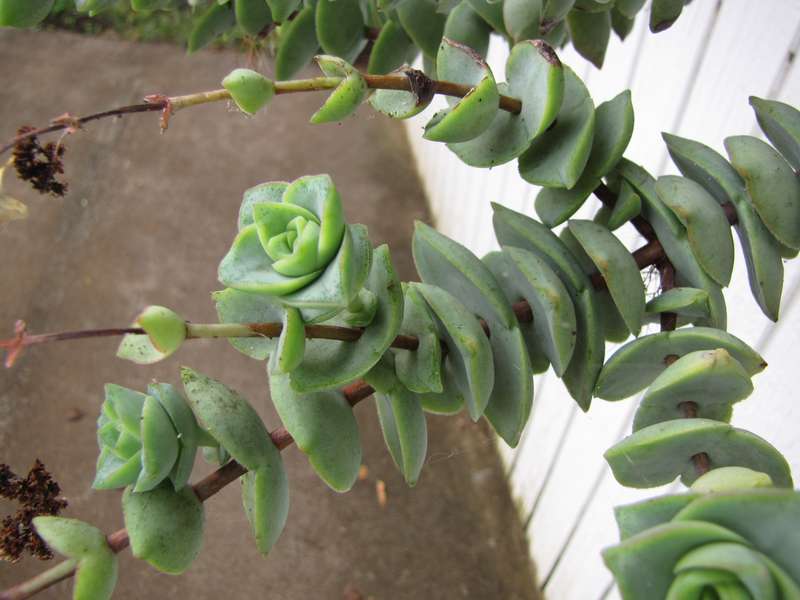
Crassula Perforata, or the String of Buttons, is a delightful succulent characterized by stacked, button-like leaves that grow on trailing stems. This plant not only creates a stunning visual effect in hanging baskets but also adds a delightful texture to your arrangements.
String of Buttons prefers bright light, thriving in bright but indirect sunlight. Water should be provided when the top layer of soil has dried out, ensuring to avoid root rot. This succulent is quite drought-tolerant and can handle neglect, making it a fantastic option for busy enthusiasts.
With its beauty-enhancing climbing habit and vibrant foliage, the String of Buttons makes a playful addition to varied arrangements.
Porcelain Flower – Hoya Pachyclada
Hoya Pachyclada, known as the Porcelain Flower, is a unique succulent with thick, waxy leaves that can produce incredibly fragrant clusters of star-shaped flowers. This particular Hoya thrives in hanging baskets, where its long vines can cascade elegantly, making it both a visual and aromatic treat.
Aiming for bright, indirect sunlight will help this plant bloom abundantly. Its soil should be well-draining, and you will need to water it when the soil has dried out. As a tropical plant, Hoya Pachyclada appreciates higher humidity levels, ensuring a healthy environment for flowering.
The beautiful combination of its lush green leaves and fragrant blooms will surely delight any home, providing a sensory experience like no other.
Lantern Flower – Ceropegia Haygarthii
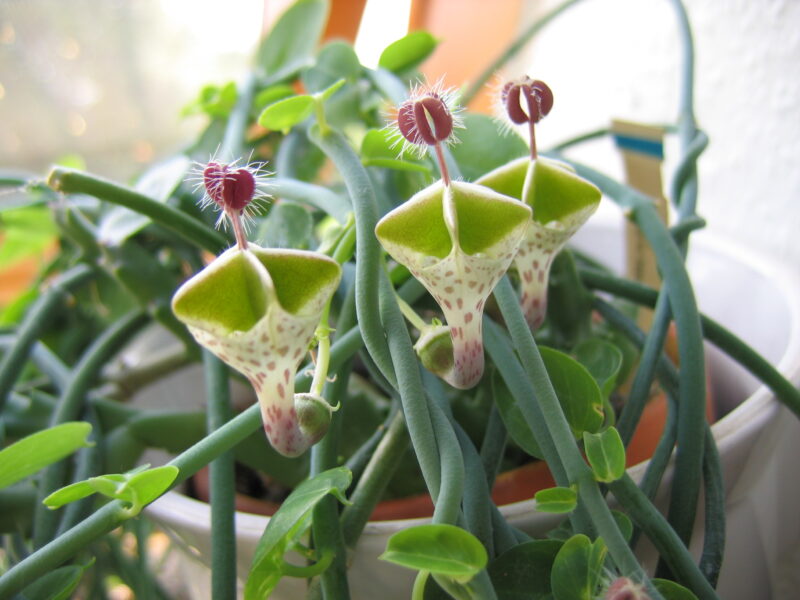
Ceropegia Haygarthii, or the Lantern Flower, showcases lovely, tubular flowers that bloom in hues of maroon, forming delightful lantern shapes. This succulent brings a unique charm to hanging arrangements with its cascading growth habit and captivating flowers.
This adorable plant resides best in bright, indirect sunlight and will thrive in well-draining soil. Watering it should be moderate, allowing it to dry out between waterings to protect against root rot.
Not only does the Lantern Flower bring solace to any hanging arrangement, but its distinctive blooms will draw attention and admiration from onlookers, making it a fantastic addition to your indoor garden.
Ice Plant – Dorotheanthus Bellidiformis
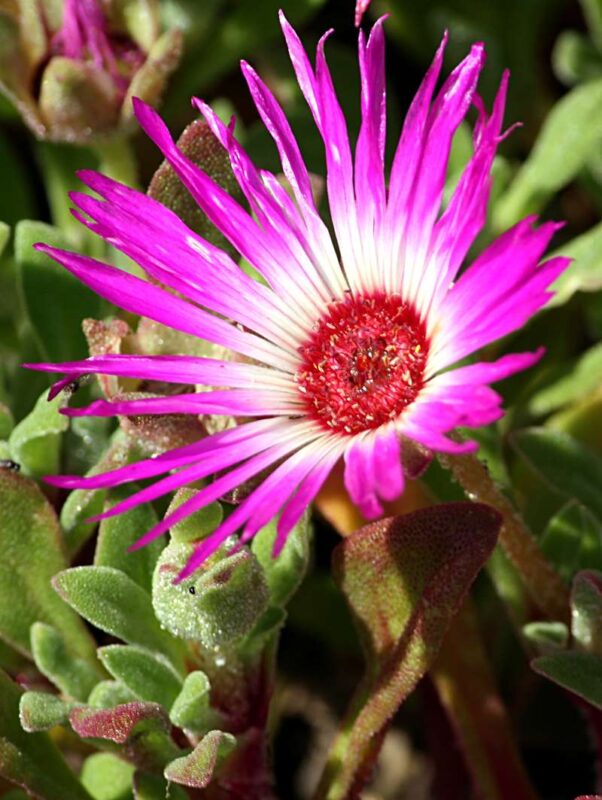
The Ice Plant (Dorotheanthus Bellidiformis) is an eye-catching succulent with sapphire-blue to fuchsia flowers that can dazzle anyone passing by. This plant produces colorful blooms during the warmer months and is perfect for hanging baskets with its stunning growth habit.
This vibrant plant prefers full sun and well-draining soil. Water sparingly—ensure the soil dries out between sessions to prevent root diseases. The rapid growth and trailing nature of this plant make it an engaging and exciting element for outdoor hanging arrangements.
With its burst of color and unique blooms, the Ice Plant captures attention while thriving in various garden settings, making it a worthy candidate for your hanging collections.


